
(a)
Interpretation:
Structural formula of the compound whose
Concept-Introduction:
Nuclear Magnetic Resonance Spectroscopy:
Nuclear Magnetic Resonance Spectroscopy or NMR Spectroscopy is a technique used to find the purity, content and molecular structure of the compound. Resonance transition between energy levels happens if
It is also known as Proton Nuclear Magnetic Resonance. Hydrogen nuclei with in the molecule is considered here.
The NMR signals for the
(a)
Explanation of Solution
Splitting in
In
In
.94ppm will the shift of
13.69ppm will the shift of
So the given values of the
Structural formula of the compound is;
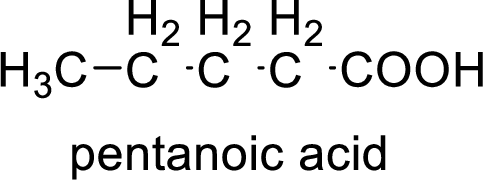
(b)
Interpretation:
Structural formula of the compound whose
Concept-Introduction:
Nuclear Magnetic Resonance Spectroscopy:
Nuclear Magnetic Resonance Spectroscopy or NMR Spectroscopy is a technique used to find the purity, content and molecular structure of the compound. Resonance transition between energy levels happens if electromagnetic radiation with specific frequency is applied on an atomic nuclei placed in an electromagnetic field. This transition happens only if the frequency of applied radiation matches with the frequency of magnetic field, then it is to be in resonance condition. If an external magnetic field is applied spin gets excited from its ground state to the excited state by absorbing energy. The absorbed radio frequency is emitted back at the same frequency level, when the spin returns to its ground state. This radio frequency will give the NMR spectra. The plot of the spectra is between Intensity of the signal VS magnetic field. Trimethyl Silane ie, TMS is used as the reference. Chemical shift is a term which refers to the position in the spectrum. It is dependent on several factors like electron density around the proton, inductive effect etc.
It is also known as Proton Nuclear Magnetic Resonance. Hydrogen nuclei with in the molecule is considered here.
The NMR signals for the
(b)
Explanation of Solution
Splitting in
In
In
1.08ppm will the shift of
30.69ppm will the shift of
So the given values of the
Structure formula of the compound is:
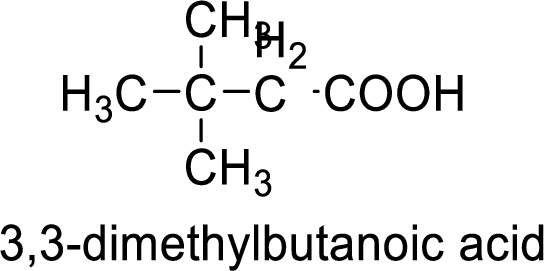
(c)
Interpretation:
Structural formula of the compound whose
Concept-Introduction:
Nuclear Magnetic Resonance Spectroscopy:
Nuclear Magnetic Resonance Spectroscopy or NMR Spectroscopy is a technique used to find the purity, content and molecular structure of the compound. Resonance transition between energy levels happens if electromagnetic radiation with specific frequency is applied on atomic nuclei placed in an electromagnetic field. This transition happens only if the frequency of applied radiation matches with the frequency of magnetic field, then it is to be in resonance condition. If an external magnetic field is applied spin gets excited from its ground state to the excited state by absorbing energy. The absorbed radio frequency is emitted back at the same frequency level, when the spin returns to its ground state. This radio frequency will give the NMR spectra. The plot of the spectra is between Intensity of the signal VS magnetic field. Trimethyl Silane ie, TMS is used as the reference. Chemical shift is a term which refers to the position in the spectrum. It is dependent on several factors like electron density around the proton, inductive effect etc.
It is also known as Proton Nuclear Magnetic Resonance. Hydrogen nuclei with in the molecule are considered here.
The NMR signals for the
(c)
Explanation of Solution
Splitting in
In
In
.93ppm will the shift of
11.81ppm will be the shift of
So the given values of the
Structural formula of the product is;
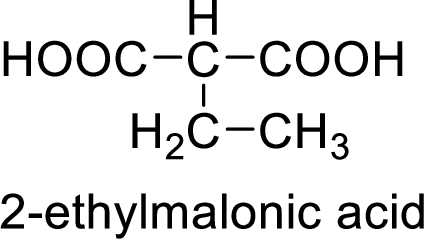
(d)
Interpretation:
Structural formula of the compound whose
Concept-Introduction:
Nuclear Magnetic Resonance Spectroscopy:
Nuclear Magnetic Resonance Spectroscopy or NMR Spectroscopy is a technique used to find the purity, content and molecular structure of the compound. Resonance transition between energy levels happens if electromagnetic radiation with specific frequency is applied on an atomic nuclei placed in an electromagnetic field. This transition happens only if the frequency of applied radiation matches with the frequency of magnetic field, then it is to be in resonance condition. If an external magnetic field is applied spin gets excited from its ground state to the excited state by absorbing energy. The absorbed radio frequency is emitted back at the same frequency level, when the spin returns to its ground state. This radio frequency will give the NMR spectra. The plot of the spectra is between Intensity of the signal VS magnetic field. Trimethyl Silane ie, TMS is used as the reference. Chemical shift is a term which refers to the position in the spectrum. It is dependent on several factors like electron density around the proton, inductive effect etc.
It is also known as Proton Nuclear Magnetic Resonance. Hydrogen nuclei with in the molecule are considered here.
The NMR signals for the
(d)
Explanation of Solution
Splitting in
In
In
1.29ppm will the shift of
22.56ppm will the shift of
So the given values of
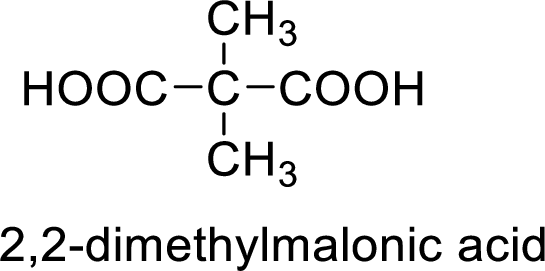
(e)
Interpretation:
Structural formula of the compound whose
Concept-Introduction:
Nuclear Magnetic Resonance Spectroscopy:
Nuclear Magnetic Resonance Spectroscopy or NMR Spectroscopy is a technique used to find the purity, content and molecular structure of the compound. Resonance transition between energy levels happens if electromagnetic radiation with specific frequency is applied on an atomic nuclei placed in an electromagnetic field. This transition happens only if the frequency of applied radiation matches with the frequency of magnetic field, then it is to be in resonance condition. If an external magnetic field is applied spin gets excited from its ground state to the excited state by absorbing energy. The absorbed radio frequency is emitted back at the same frequency level, when the spin returns to its ground state. This radio frequency will give the NMR spectra. The plot of the spectra is between Intensity of the signal VS magnetic field. Trimethyl Silane ie, TMS is used as the reference. Chemical shift is a term which refers to the position in the spectrum. It is dependent on several factors like electron density around the proton, inductive effect etc.
It is also known as Proton Nuclear Magnetic Resonance. Hydrogen nuclei with in the molecule are considered here.
The NMR signals for the
(e)
Explanation of Solution
Splitting in
In
In
1.91ppm will the shift of
18.11ppm will the shift of
So the given values of
Structural formula of the product;
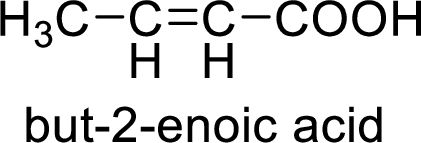
(f)
Interpretation:
Structural formula of the compound whose
Concept-Introduction:
Nuclear Magnetic Resonance Spectroscopy:
Nuclear Magnetic Resonance Spectroscopy or NMR Spectroscopy is a technique used to find the purity, content and molecular structure of the compound. Resonance transition between energy levels happens if electromagnetic radiation with specific frequency is applied on an atomic nuclei placed in an electromagnetic field. This transition happens only if the frequency of applied radiation matches with the frequency of magnetic field, then it is to be in resonance condition. If an external magnetic field is applied spin gets excited from its ground state to the excited state by absorbing energy. The absorbed radio frequency is emitted back at the same frequency level, when the spin returns to its ground state. This radio frequency will give the NMR spectra. The plot of the spectra is between Intensity of the signal VS magnetic field. Trimethyl Silane ie, TMS is used as the reference. Chemical shift is a term which refers to the position in the spectrum. It is dependent on several factors like electron density around the proton, inductive effect etc.
It is also known as Proton Nuclear Magnetic Resonance. Hydrogen nuclei with in the molecule are considered here.
The NMR signals for the
(f)
Explanation of Solution
Splitting in
In
In
2.34ppm will the shift of
34.02ppm will the shift of
So the given values of
Structure of the product
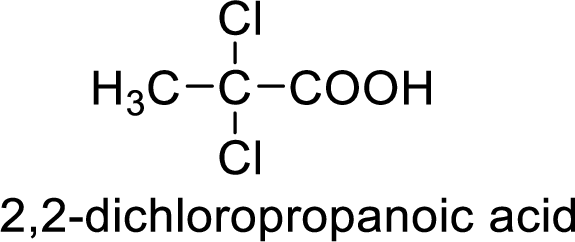
(g)
Interpretation:
Structural formula of the compound whose
Concept-Introduction:
Nuclear Magnetic Resonance Spectroscopy:
Nuclear Magnetic Resonance Spectroscopy or NMR Spectroscopy is a technique used to find the purity, content and molecular structure of the compound. Resonance transition between energy levels happens if electromagnetic radiation with specific frequency is applied on an atomic nuclei placed in an electromagnetic field. This transition happens only if the frequency of applied radiation matches with the frequency of magnetic field, then it is to be in resonance condition. If an external magnetic field is applied spin gets excited from its ground state to the excited state by absorbing energy. The absorbed radio frequency is emitted back at the same frequency level, when the spin returns to its ground state. This radio frequency will give the NMR spectra. The plot of the spectra is between Intensity of the signal VS magnetic field. Trimethyl Silane ie, TMS is used as the reference. Chemical shift is a term which refers to the position in the spectrum. It is dependent on several factors like electron density around the proton, inductive effect etc.
It is also known as Proton Nuclear Magnetic Resonance. Hydrogen nuclei with in the molecule are considered here.
The NMR signals for the
(g)
Explanation of Solution
Splitting in
In
In
1.42ppm will the shift of
13.69ppm will the shift of
So the given values of

(h)
Interpretation:
Structural formula of the compound whose
Concept-Introduction:
Nuclear Magnetic Resonance Spectroscopy:
Nuclear Magnetic Resonance Spectroscopy or NMR Spectroscopy is a technique used to find the purity, content and molecular structure of the compound. Resonance transition between energy levels happens if electromagnetic radiation with specific frequency is applied on an atomic nuclei placed in an electromagnetic field. This transition happens only if the frequency of applied radiation matches with the frequency of magnetic field, then it is to be in resonance condition. If an external magnetic field is applied spin gets excited from its ground state to the excited state by absorbing energy. The absorbed radio frequency is emitted back at the same frequency level, when the spin returns to its ground state. This radio frequency will give the NMR spectra. The plot of the spectra is between Intensity of the signal VS magnetic field. Trimethyl Silane ie, TMS is used as the reference. Chemical shift is a term which refers to the position in the spectrum. It is dependent on several factors like electron density around the proton, inductive effect etc.
It is also known as Proton Nuclear Magnetic Resonance. Hydrogen nuclei with in the molecule are considered here.
The NMR signals for the
(h)
Explanation of Solution
Splitting in
In
In
97ppm will the shift of
13.24ppm will the shift of
So the given values of
Structural formula of the compound is;
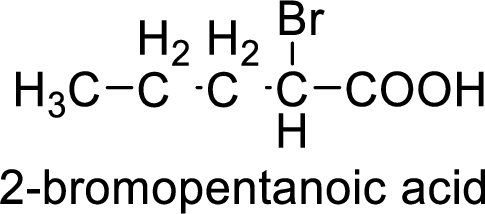
(i)
Interpretation:
Structural formula of the compound whose
Concept-Introduction:
Nuclear Magnetic Resonance Spectroscopy:
Nuclear Magnetic Resonance Spectroscopy or NMR Spectroscopy is a technique used to find the purity, content and molecular structure of the compound. Resonance transition between energy levels happens if electromagnetic radiation with specific frequency is applied on atomic nuclei placed in an electromagnetic field. This transition happens only if the frequency of applied radiation matches with the frequency of magnetic field, then it is to be in resonance condition. If an external magnetic field is applied spin gets excited from its ground state to the excited state by absorbing energy. The absorbed radio frequency is emitted back at the same frequency level, when the spin returns to its ground state. This radio frequency will give the NMR spectra. The plot of the spectra is between Intensity of the signal VS magnetic field. Trimethyl Silane ie, TMS is used as the reference. Chemical shift is a term which refers to the position in the spectrum. It is dependent on several factors like electron density around the proton, inductive effect etc.
It is also known as Proton Nuclear Magnetic Resonance. A hydrogen nucleus with in the molecule is considered here.
The NMR signals for the
(i)
Explanation of Solution
Splitting in
In
In
3.38ppm will the shift of
34.75ppm will the shift of
So the given values of
So the structure of the product is;
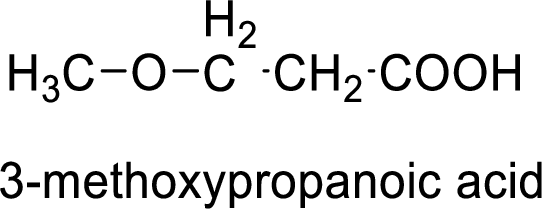
Want to see more full solutions like this?
Chapter 17 Solutions
Organic Chemistry
- K Most Reactive Na (3 pts) Can the metal activity series (shown on the right) or a standard reduction potential table explain why potassium metal can be prepared from the reaction of molten KCI and Na metal but sodium metal is not prepared from the reaction of molten NaCl and K metal? Show how (not). Ca Mg Al с Zn Fe Sn Pb H Cu Ag Au Least Reactivearrow_forward(2 pts) Why is O2 more stable as a diatomic molecule than S2?arrow_forwardDraw the Lewis structure for the polyatomic phosphite (PO¾³¯) a anion. Be sure to include all resonance structures that satisfy the octet rule. C I A [ ]¯arrow_forward
- Decide whether these proposed Lewis structures are reasonable. proposed Lewis structure Is the proposed Lewis structure reasonable? Yes. :0: Cl C C1: 0=0: : 0 : : 0 : H C N No, it has the wrong number of valence electrons. The correct number is: ☐ No, it has the right number of valence electrons but doesn't satisfy the octet rule. The symbols of the problem atoms are:* ☐ Yes. No, it has the wrong number of valence electrons. The correct number is: ☐ No, it has the right number of valence electrons but doesn't satisfy the octet rule. The symbols of the problem atoms are:* Yes. ☐ No, it has the wrong number of valence electrons. The correct number is: ☐ No, it has the right number of valence electrons but doesn't satisfy the octet rule. The symbols of the problem atoms are:* | * If two or more atoms of the same element don't satisfy the octet rule, just enter the chemical symbol as many times as necessary. For example, if two oxygen atoms don't satisfy the octet rule, enter "0,0".arrow_forwardDraw the Lewis structure for the polyatomic trisulfide anion. Be sure to include all resonance structures that satisfy the octet rule. с [ ] - Garrow_forward1. Calculate the accurate monoisotopic mass (using all 1H, 12C, 14N, 160 and 35CI) for your product using the table in your lab manual. Don't include the Cl, since you should only have [M+H]*. Compare this to the value you see on the LC-MS printout. How much different are they? 2. There are four isotopic peaks for the [M+H]* ion at m/z 240, 241, 242 and 243. For one point of extra credit, explain what each of these is and why they are present. 3. There is a fragment ion at m/z 184. For one point of extra credit, identify this fragment and confirm by calculating the accurate monoisotopic mass. 4. The UV spectrum is also at the bottom of your printout. For one point of extra credit, look up the UV spectrum of bupropion on Google Images and compare to your spectrum. Do they match? Cite your source. 5. For most of you, there will be a second chromatographic peak whose m/z is 74 (to a round number). For one point of extra credit, see if you can identify this molecule as well and confirm by…arrow_forward
- Please draw, not just describe!arrow_forwardcan you draw each step on a piece of a paper please this is very confusing to mearrow_forward> Can the molecule on the right-hand side of this organic reaction be made in good yield from no more than two reactants, in one step, by moderately heating the reactants? esc ? A O O •If your answer is yes, then draw the reactant or reactants in the drawing area below. You can draw the reactants in any arrangement you like. • If your answer is no, check the box under the drawing area instead. olo 18 Ar Explanation Check BB Click and drag to start drawing a structure. 2025 McGraw Hill LLC. All Rights Reserved. Terms of Use | Privacy Center Accessibilityarrow_forward
- Name the structurearrow_forward> For each pair of substrates below, choose the one that will react faster in a substitution reaction, assuming that: 1. the rate of substitution doesn't depend on nucleophile concentration and 2. the products are a roughly 50/50 mixture of enantiomers. Substrate A Substrate B Faster Rate X CI (Choose one) (Choose one) CI Br Explanation Check Br (Choose one) C 2025 McGraw Hill LLC. All Rights Reserved. Terms of Use | Privacy A F10arrow_forwardHow to draw this mechanism for the foloowing reaction in the foto. thank youarrow_forward
 Organic ChemistryChemistryISBN:9781305580350Author:William H. Brown, Brent L. Iverson, Eric Anslyn, Christopher S. FootePublisher:Cengage Learning
Organic ChemistryChemistryISBN:9781305580350Author:William H. Brown, Brent L. Iverson, Eric Anslyn, Christopher S. FootePublisher:Cengage Learning

